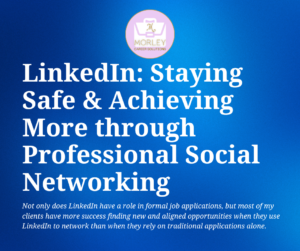
When you apply for a job, or a recruiter/manager reaches out to gauge your interest in a new opening, what’s the first document you’re asked to provide?
If you answered a résumé, you would be right about 80% of the time.
What’s the second document you’re asked for?
No, not a cover letter. Although they still have their uses, cover letters are actually becoming less popular. In fact, the 20% of hiring managers and recruiters who don’t ask for a résumé first, ask for a link to your LinkedIn profile first.
Yes, LinkedIn has become that important to the job search. Not only does it have a role in formal job applications, but most of my clients have more success finding new and aligned opportunities when they use LinkedIn to network than when they rely on traditional applications alone.
What does that mean for you — either as a job seeker or as someone open to opportunity?
1. Update Your LinkedIn Profile Regularly
Updating your LinkedIn profile regularly is no longer optional if you’re keeping your options open.
I have worked with clients who were passed over for job opportunities simply because they didn’t have a LinkedIn profile or couldn’t put one together fast enough to be considered for a fast-tracked position.
Many employers require their employees to have updated LinkedIn profiles as this reflects professionalism and can be traced to improvements in sales and/or customer satisfaction.
So, taking a haphazard approach to updating LinkedIn isn’t the best strategy. Instead, I recommend you find time each week to spend on LinkedIn. During this time, you can make minor changes to your profile. Add a certificate you earned, move an achievement over to your featured section, and adjust a few skills.
2. Be Mindful of Your Privacy
The emergence of LinkedIn as a required career document demonstrates a pretty big shift in the career world — a shift from private to public. Of course, we’ve been making that shift for a while now. Take a moment just to think about how much this has changed. Resumes, cover letters, and interviews were once intensely private affairs. Do you remember when most resumes had the word “confidential” stamped on them?
In the interest of transparency, collaboration, and perhaps (hopefully) community, we’ve definitely swung the other way, with the requirement of a public LinkedIn profile for most job applications. There are absolutely benefits to this — the more transparent, collaborative, and communicative we can be with each other, the more aligned, effective, and cooperative our world will be — at least in this dreamer’s opinion.
However, most of the clients who have reluctantly joined LinkedIn after my coaching have been so reluctant because of privacy issues.
So, how can you create a LinkedIn profile while staying mindful of your privacy?
- Omit Public Contact Info: Like most online services, you will need an email address or phone number to sign up for LinkedIn. However, LinkedIn allows you to choose whether your contact information, including your email, will be visible to the public. I recommend against providing contact information, other than in a few specific situations, such as certain types of sales. LinkedIn includes its own messaging platform, which requires someone to either connect with you or purchase InMail credits to reach you. This is an extra barrier protection that LinkedIn uses so that you don’t have to suffer through messages or spam that you aren’t interested in. Let potential contacts use the LinkedIn system to contact you. Anyone who genuinely wants to connect with you can do cell relatively easily, especially since LinkedIn allows users to send a message with a connection request. Making your contact info public, however, invites spam and potential invasion of privacy.
- Consider Your Audience: Many of my clients are wary of LinkedIn because they are concerned that their current employers will assume that by being on LinkedIn, they are looking for new jobs — and fast! As I mentioned before, this isn’t true. Most employers prefer their employees to be on LinkedIn. However, it certainly makes sense to consider that your current employer might be reading your posts or profile. So, if you’re concerned about retaliation, keep comments vague. Explain that you’re “open to meeting like-minded people” rather than searching for career opportunities. Send private messages when it comes to inquiring specifically about open jobs.
- Avoid Statistics and Other Specific Information: When I write a LinkedIn profile for my clients, I typically avoid providing sales numbers, statistics, or other potentially confidential information. This kind of information is best suited for a resume, which you still have the option of stamping “confidential”! Instead, summarize your achievement. Instead of explaining that you managed a $3.3M book of business, explain that you managed significant and key accounts.
3. Engage
This is the big one — perhaps one of the scariest or most exciting aspect of LinkedIn, depending on your personality. Engagement as a way to position yourself as a top candidate is also newer and faster than many job search strategies. What is engagement? Put simply, engagement is how you utilize the LinkedIn platform to publicly connect with people and ideas. Examples of engagement include commenting on others’ posts, sharing a post with your comments, writing an article, and/or participating in a collaborative article.
Unlike other social media platforms, your LinkedIn engagement shows up right under your name, and employers often use it to get a sense of your personality and mission. An ex-Amazon recruiter recently told CNBC that employers spend 25 times longer on candidates’ LinkedIn profiles than on their resumes.
So, remember that weekly time block I suggested you take for LinkedIn? Use that to do more than update your profile. Use it to engage as well.
If you would like to talk more about how LinkedIn can be part of your job-search strategy, feel free to text me at 708-730-4694 or book a call here: https://morleycareersolutions.com/contact/
